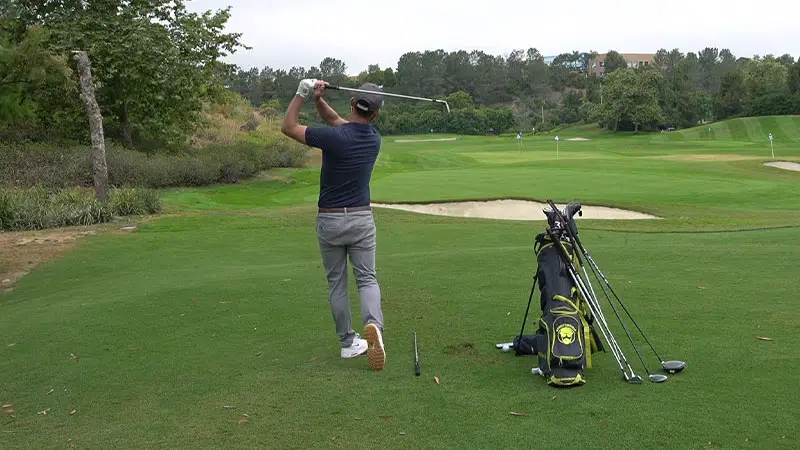Understanding spin rate is crucial for golfers aiming to improve their game, especially when it comes to the 7 iron. Spin rate, measured in RPMs, significantly impacts the height, distance, and control of your shots.
For instance, professional golfers on the PGA Tour average a spin rate of around 7,000 RPM with their 7 irons, showcasing the importance of mastering this aspect.
Spin rate isn’t just about how fast the ball spins; it also affects how the ball behaves in various conditions. A high spin rate can be advantageous for stopping the ball quickly on the green, but it can be a nightmare in windy conditions.
By learning to manage the spin rate of your 7 iron, you can gain better control over your ball flight and shot shape, leading to more consistent and accurate shots.
Understanding Spin Rate in Golf
Spin rate in golf refers to the rate at which the golf ball rotates around its axis while it’s in flight. It’s a crucial factor in determining the ball’s trajectory, distance, and overall performance.
What is Spin Rate?
Spin rate refers to the number of revolutions per minute (RPMs) that a golf ball undergoes after being struck. This metric significantly influences the ball’s behavior during flight and its reaction upon landing.
Various factors, including swing speed, club loft, ball type, and impact point, contribute to generating spin. A typical 7 iron spin rate for professional golfers hovers around 7,000 RPM, but this value can fluctuate based on individual swing characteristics.
Why Spin Rate is Crucial for the 7 Iron
Spin rate plays a pivotal role in the performance of a 7 iron shot. A proper spin rate can enhance control, allowing for precise ball placement on the green.
Higher spin rates result in a higher ball flight and a softer landing, which is beneficial for holding greens but can be problematic in windy conditions.
Conversely, lower spin rates can lead to longer distances and a more penetrating ball flight, making it essential for golfers to understand and manage their spin rates accordingly.
Effective spin management leads to more consistent and accurate shots, enabling golfers to achieve better results in various playing conditions.
Determining Ideal 7 Iron Spin Rates
Determining the ideal spin rate for a 7 iron in golf depends on various factors, including player skill level, swing speed, launch angle, and course conditions.
However, as a general guideline:
Factors Influencing Spin Rate
Various factors affect the spin rate of a 7 iron, impacting shot performance. Swing speed, one primary factor, determines the overall power and the resultant spin.
A faster swing speed usually results in higher spin rates. Club loft also affects spin; irons with higher lofts generate more backspin.
Additionally, the type of golf ball influences spin rates due to their construction and surface texture. Impact point hugely impacts spin; strikes closer to the sweet spot ensure the most efficient spin generation.
Lastly, friction between the clubface and the ball, often affected by weather and course conditions, plays a crucial role in spin rates.
Tour Player Spin Rate Benchmarks
Benchmarking against professional golfers provides valuable insights. PGA Tour players typically achieve a spin rate around 7,000 RPM with their 7 irons.
Comparatively, a 5-handicap male golfer might generate slightly lower spin rates. Averaging between 6,000 and 7,000 RPMs, strong amateur players aim to be within a few hundred RPMs of these professional benchmarks.
These spin rates ensure optimal height and control, balancing distance and stopping power on the green. Golfers should use launch monitors to track and adjust their spin rates, maintaining consistency with established benchmarks for improved performance.
Techniques to Optimize 7 Iron Spin
Optimizing spin with a 7 iron in golf can significantly impact shot control, distance, and stopping power on the green.
Here are some techniques to help you achieve the desired spin:
Adjusting Swing Mechanics
Optimizing swing mechanics greatly influences 7 iron spin rates. Shallowing the angle of attack into the ball can reduce excessive spin.
Golfers should work on ensuring that their clubface meets the ball squarely during impact for more controlled spin.
Incorporating a smoother, more even-tempo backswing and follow-through can help maintain consistency. Mastering weight transfer during the swing helps improve contact and results in more predictable spin rates.
Choosing the Right Equipment
Selecting appropriate equipment is essential for achieving optimal 7 iron spin rates. Golf shafts play a crucial role; for example, lighter shafts like the KBS TourV 110g can offer lower spin compared to heavier ones such as the KBS Tour 120g.
High-launch shafts like the Steel Fiber 95 encourage higher spin, aiding in achieving the desired ball trajectory. Adjusting the club’s loft also affects spin; higher loft typically increases spin rate.
Golfers should consider ball choice since different balls offer varying spin characteristics, thus impacting overall performance.
Maintaining an optimal spin rate requires a balance between technique refinement and equipment adjustments.
Spin Rate and Golf Ball Performance
Spin rate plays a crucial role in golf ball performance, influencing various aspects of ball flight and overall playability.
Here’s how spin rate impacts golf ball performance:
How Spin Impacts Ball Trajectory
Spin rate significantly affects the trajectory of a golf ball. High spin rates generate more lift, resulting in higher ball flight and a steeper descent angle.
This is beneficial for shots needing quick stops on the green. Conversely, lower spin rates produce a flatter trajectory with more roll upon landing.
Players looking for distance over precision should aim for lower spin rates. For context, professional golfers target about 7,000 RPM with their 7 iron for an optimal balance between height and control.
Adjustments for Different Course Conditions
Different course conditions necessitate varying spin rate adjustments. In windy conditions, high spin rates can exaggerate wind effects, making shots unpredictable.
Lowering the spin rate helps stabilize the ball flight. On soft ground, higher spin helps the ball stop quicker, while on hard ground, a lower spin might prevent unwanted extra roll.
Players can adjust their swing mechanics, club loft, and ball type to adapt their spin rates to the course condition, enhancing overall performance.
Frequently Asked Questions
What is the optimal spin rate for a 7 iron?
Professional golfers typically aim for around 7,000 RPM with their 7 irons for peak performance. This spin rate helps achieve a balanced shot height, distance, and control.
How does spin rate affect my golf shot?
Spin rate influences shot height, distance, and control. Higher spin rates result in higher ball flight and steeper descent angles, which are beneficial for precise shots on the green. Lower spin rates offer more roll for longer distance shots.
What factors influence the spin rate of a 7 iron?
Several factors impact spin rate, including swing speed, club loft, ball type, impact point, and weather conditions. Adjustments in these areas can help optimize your spin rates depending on the scenario.
How can I adjust my spin rate based on course conditions?
Adapting your spin rate to course conditions is crucial. In windy conditions, lower spin rates provide more stability, while on soft ground, higher spin rates help achieve quicker stops. Fine-tuning your swing mechanics, club loft, and ball type can assist in these adjustments.
Can changing my swing mechanics help with spin rate?
Yes, modifying your swing mechanics can influence your spin rate. A consistent and controlled swing can help achieve the desired spin rate for different playing conditions, enhancing overall performance.
Conclusion
Mastering the spin rate for a 7 iron is crucial for any golfer aiming to enhance their game. By understanding how factors like swing speed, club loft, and ball type affect spin, players can make informed adjustments for optimal performance.
Whether aiming for precise shots on the green or maximizing distance, adapting spin rates to match course conditions is key.
With the right balance of technique and equipment, golfers can achieve greater control and consistency, ultimately improving their overall performance on the course.
In addition, practicing regularly with a launch monitor can provide valuable data on spin rates, allowing golfers to fine-tune their swings and equipment choices.
Consistent feedback helps identify areas for improvement and track progress, ensuring that adjustments lead to tangible results.
Investing time in understanding and optimizing your 7 iron spin rate is a practical step towards a more refined and effective golfing experience.








Colin McCarthy